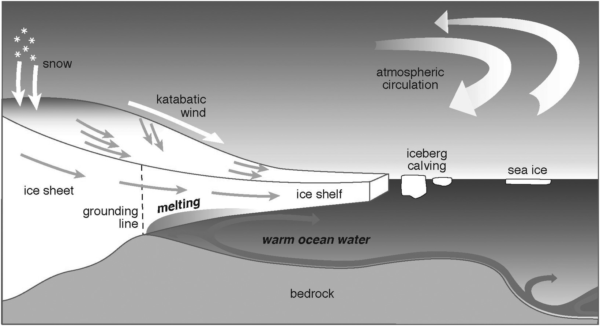RealClimate: Why is sea level rise so hard? Data, modeling and projection challenges still exist even while we make incremental progress.
Source: RealClimate: Why is future sea level rise still so uncertain?
Why is future sea level rise still so uncertain?
Filed under:
— gavin @ 12 May 2021
Three new papers in the last couple of weeks have each made separate claims about whether sea level rise from the loss of ice in West Antarctica is more or less than you might have thought last month and with more or less certainty. Each of these papers make good points, but anyone looking for coherent picture to emerge from all this work will be disappointed. To understand why, you need to know why sea level rise is such a hard problem in the first place, and appreciate how far we’ve come, but also how far we need to go.

Here’s a list of factors that will influence future regional sea level (in rough order of importance):
- ice mass loss from West Antarctica
- ice mass loss from Greenland
- ocean thermal expansion
- mountain glacier melt
- gravitational, rotational and deformational (GRD) effects
- changes in ocean circulation
- steric (freshwater/salinity) effects
- groundwater extraction
- reservoir construction and filling
- changes in atmospheric pressure and winds
And on top of that, the risks of coastal flooding also depend on:
- tectonic/isostatic land motion
- local subsidence
- local hydrology
- storm surges
- tides
If that wasn’t bad enough, it doesn’t even get into why some of the bigger terms here are so difficult to constrain – but more of that below.
Meanwhile, note that the factors listed above involve the whole Earth system: the oceans, the cryosphere, the atmosphere, the solid earth and lithosphere, and a full range of scales, from the city block and shoreline, to ice dynamics that change over kilometers, to GRD footprints, to the whole global ocean. While each of these elements has a devoted scientific community, sea level rise cuts across all the disciplines. And similarly, while each of these elements has a specialized modeling capability, there is no single model that encompasses all of this (not even close – as yet).
What this means is that estimates of future sea level rise are mixes of information from multiple sources, tied together in more or less sophisticated frameworks (this is the approach in the IPCC SCROCC report and the upcoming AR6) that attempt to build a full uncertainty range from all the disparate sources of information (coupled ocean-atmosphere models, hydrology models, ice sheet models, solid earth models etc.). To reiterate, there is no ‘climate model’ prediction of global sea level rise, though the climate models we often discuss here (the CMIP-class of models), do provide some of the inputs. This means that links and feedbacks between these different elements are not always coherent – e.g. the estimates of groundwater depletion (used for irrigation) or glacier melt might not impact the soils or the freshwater budget of the downstream rivers and ocean.
Yes, but what about West Antarctica?
The West Antarctic Ice Sheet (WAIS) is the elephant seal in the aquarium. Ever since the 1970s it’s been suspected that it was prone to rapid collapse because the bedrock on which it sits is below sea level (and in some places, thousands of meters below sea level). More recent research constraining Eemian sea level (~125,000 yrs ago) has confirmed that WAIS collapsed at that time, adding 3 or more meters of sea level rise to the contribution from a much reduced Greenland Ice Sheet. Moreover, present day observations from gravity sensors (GRACE/GRACE-FO) show large ice mass losses from WAIS – dominated by the rapid retreats of the Pine Island Glacier and Thwaites glacier, and concomittent decreases in ice sheet elevation (from IceSat2).

There are many interesting observations and non-observations from WAIS that make this a challenging problem. First, the melting of the ice shelves and the retreat of grounding line is being driven from below as slighty warmer circumpolar deep water (CPDW) has been pushed onto the shelf. The CPDW is thought to be affected by the shift in the westerly winds around Antarctica which have increased in recent decades due to a combination of greenhouse gas forcing and the polar ozone hole (Miller et al, 2006).
Leave a Reply